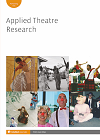
Full text loading...
This article analyses the implementation of a theatrical performance for the prevention of micro-chauvinism violence and the promotion of equality created by vocational training students and aimed at secondary school students. Using a qualitative research methodology based on case studies and the use of narratological and semiotic models of theatrical reception, this work focuses on analysing the acting roles of the characters who represent situations of micro-chauvinism in adolescence, and understanding the theatrical performative characteristics of the artistic work. The results allow us to draw conclusions about the advantages of theatre applied to education to diagnose the current situation of youth micro-chauvinism; the orchestration of teaching with a gender perspective through the dramatization of micro-chauvinism among young adolescents; and the choreographies of learning for the promotion of gender equality through theatre applied to education.

Article metrics loading...

Full text loading...
References


Data & Media loading...

Publication Date:
https://doi.org/10.1386/atr_00080_1 Published content will be available immediately after check-out or when it is released in case of a pre-order. Please make sure to be logged in to see all available purchase options.